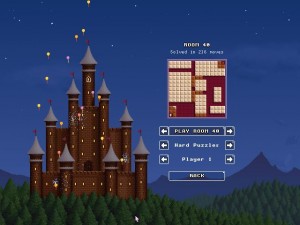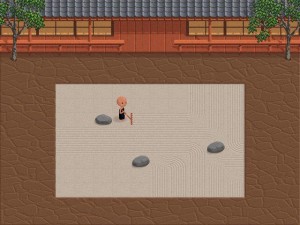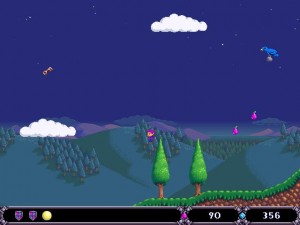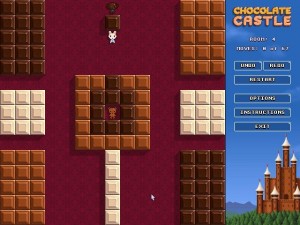Chocolate Castle
 I polished off Chocolate Castle last night. It’s definitely the most compelling of the Lexaloffle minigames, as well as the most polished.
I polished off Chocolate Castle last night. It’s definitely the most compelling of the Lexaloffle minigames, as well as the most polished.
Most puzzles in this game have a structure that can be chopped into distinct stages. For example, you might have a rabbit (which eats white chocolate) trapped inside a dark chocolate block, so your first goal is to get all the dark chocolate together so you can clear it, then turn your attention to the white. Towards the end, the sub-goals become subtler, more a matter of getting one particularly awkward block past another in order to free up some space for the manipulations you really want to do. Sometimes the sub-goals were so numerous, and took me so long to execute, that I wished I could save my progress within a level, or even keep multiple such saves in cases where I wasn’t sure if I was taking the right approach. Ah well, at least the game lets you undo arbitrarily. It even accepts the standard Windows idioms for undo/redo hotkeys, which Zen Puzzle Garden didn’t.
Speaking of cases where I wasn’t sure if I was taking the right approach, there’s one mechanism that’s all but guaranteed this sensation: Turkish delight. This is a rare confection, eaten by cats, which then explode, destroying all adjacent walls and chocolate. Where other confections tend to come in large blocks that limit where you can drag them to, Turkish delight is always just one tile in size, and therefore very portable. So, it’s a tool for making a hole anywhere you want — but there’s likely only one spot where it actually does any good, and it’s not necessarily obvious. On one level, I didn’t even use it to blow up a wall. I used to to chop up a snake instead.
Snakes are another game element I haven’t described. They’re essentially a sort of block that’s a sort of rope. You drag them by the head, and the body, which occupies multiple tiles, follows behind in the manner you’d expect of a snake on a grid in a videogame. Sever it, and it turns into two snakes. It’s also capable of eating rabbits, if you drag it through them. I assume it’s capable of eating other animals as well, but I don’t remember any opportunities to confirm this, whereas there’s one level where eating rabbits is hard to avoid. After completing each level, you’re rewarded with confetti and balloons. If any rabbits got eaten, the balloons are black, which feels a bit like the game is scolding you for taking the easy way out.
But snakes and Turkish delight are both rare. Mostly the game just keeps on finding ways to exploit its base rules, right up to the end.
 Comments(0)
Comments(0)

